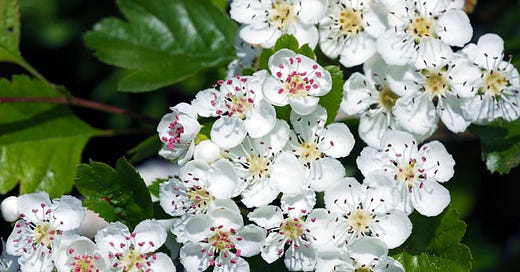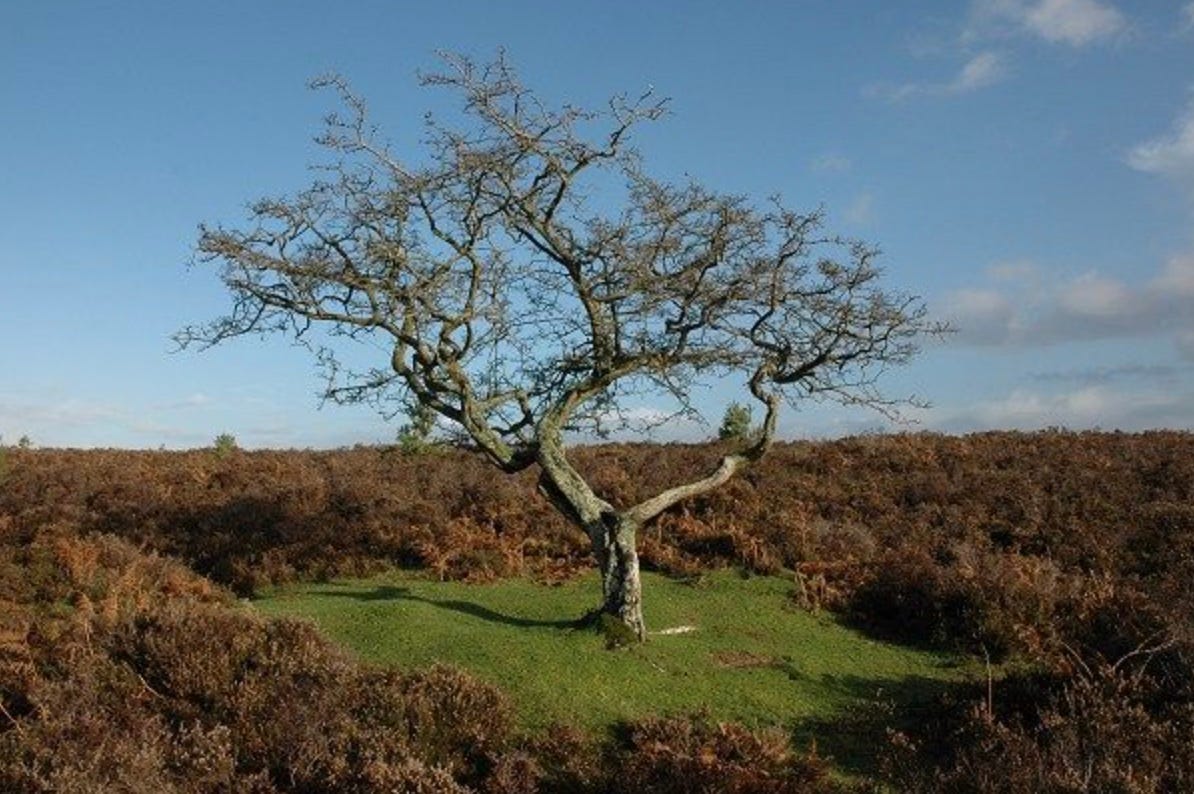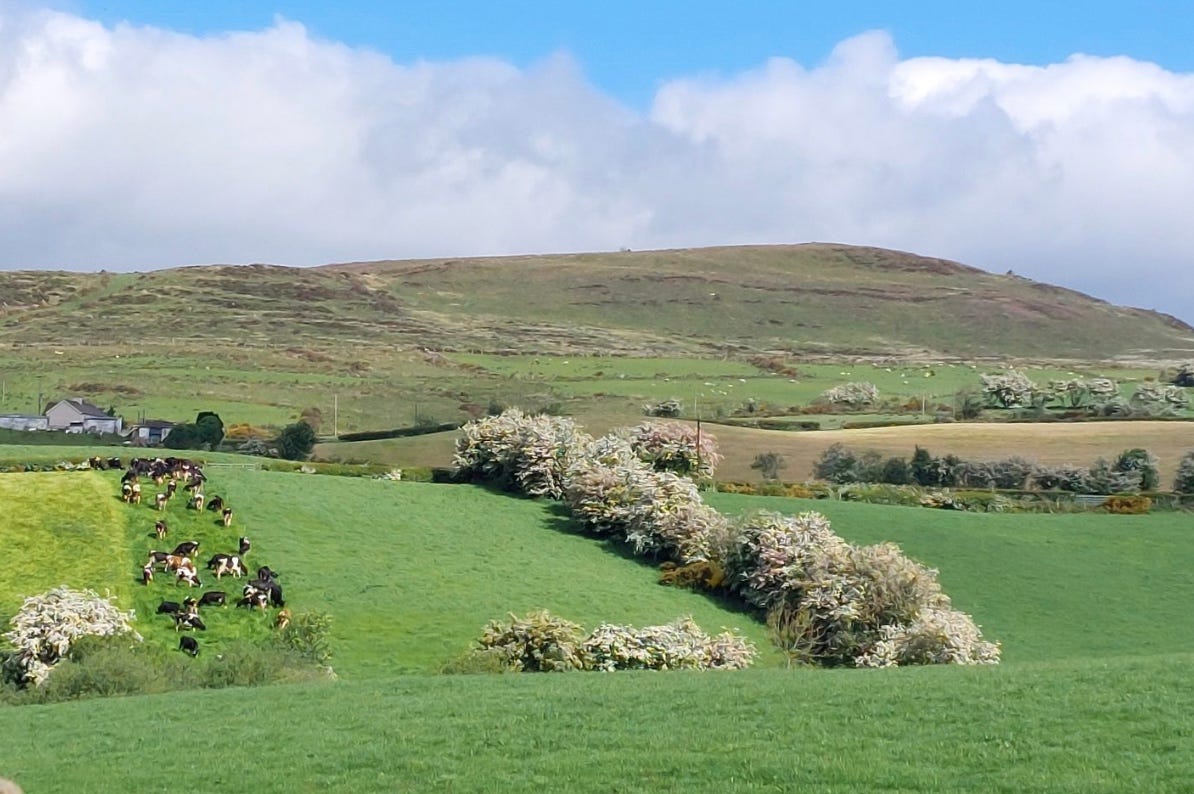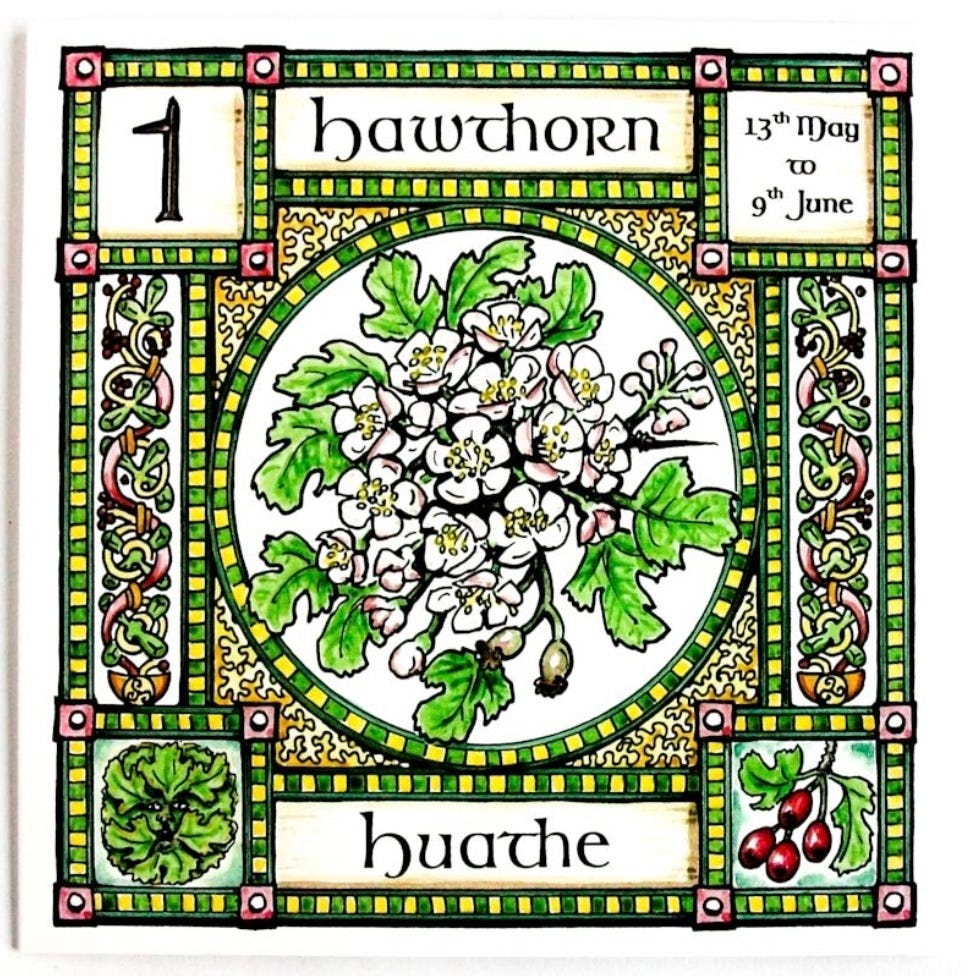In the buzz of summer energy and the Bank Holiday weekend, I muddled my post timeline and didn’t share my next Trees of Ireland piece as planned. I wonder if anyone noticed. But perhaps this week is more fitting, for as we follow the Celtic Ogham calendar through the year, we now land in the second week of May—very much the time of the hawthorn.
Here is a tree with a resounding presence and deep significance in Ireland. A tree that seems to embody the spirit of this land—mythological, medicinal, ecological, and protective. It’s hard to know where to begin with hawthorn, but begin we must. This is a tree that reveals a different character in every season, but in the blessed month of May, the hawthorn makes itself truly known, blazing along roadsides and in the hedgerows with a flush of bright white blossoms—the very symbol of purity, vitality, life, and renewal.
First Encounters
Have you ever heard the story of the Latoon Fairy Tree? It’s a lone hawthorn near Ennis, Co. Clare, that was nearly destroyed during the building of the M18 motorway. But thanks to the efforts of storyteller and folklorist Eddie Lenihan—who spoke publicly and persistently about the spirits said to dwell there—it was saved. The road was rerouted. To this day, the tree stands alone in a field between lanes of traffic, untouched, revered, and protected. In the words of Mr Lenihan;
"If you move or destroy a fairy fort or Celtic ringfort, you'll be in trouble and you're creating trouble. Never shift a fairy bush. It belongs where it is and nowhere else".
Anyone who begins to explore Ireland’s mythology or sacred landscape soon meets this tree. My first and most significant encounters with hawthorn have been woven into my own journeys around Ireland. You see, if this Substack is about anything, it is about singing the world back into life. It’s a reminder that everything around us is alive—infused with soul and spirit—and that in deepening our relationship with the natural world, we begin to inhabit the earth in a more meaningful way. Ireland is a very special place. During the so-called Dark Ages, when the Roman Empire was collapsing, we were a beacon of light—a place of learning, of sanity, where the natural world and spirituality remained deeply intertwined. That reality still emanates from the land. It is ever-present, and nowhere more so than at our sacred sites. It is there I’ve encountered this tree again and again.
First, at Carrowkeel in Sligo, as you ascend the hill toward the ancient cairns, a hawthorn tree guards the entrance to the final path. It is said you must pause here, speak your name, and declare your intention before continuing. Second, at Loughcrew in Meath. While a new trail has been made for tourists, those in the know still take the older path—which passes another hawthorn guardian, and again, the proper thing is to greet the tree and share your purpose. The third I remember well lives deep in the Coomhola Valley in West Cork, standing like a lone sentinel over the land. Its presence is unmistakable. It is a brave—or perhaps foolish—person who would dare lay a hand on it, or on any of these trees. These are just a few examples but they are found throughout Ireland, many a time as you drive the laneways and country roads of Ireland, you can be suddenly struck by the presence of a lone hawthorn tree standing in a field. And now in this time of May, the period of Bealtaine-the celebration of summer-I will visit the Hill of Uisneach-the navel of Ireland-to celebrate this time with 5000 other people as we light a great fire and welcome in the arrival of the time of the Hawthorn, a celebration of early Summer and the return of the sun.
A Tree of Blossom and Thorn
Most everyone will pass a hawthorn at least once throughout their day. Ireland is laced with nearly 690,000km of hedgerows, and the hawthorn is their undisputed queen. In places like Kildare and Sligo, it makes up close to 90% of all hedgerows, a testament to its deep-rooted presence here. These hedgerows our vital lifelines to the wildlife of Ireland. They are far more than fences; they are living ecosystems, sheltering birds, bees, and countless small creatures. In a land where forests have largely disappeared, hedgerows act as vital corridors of biodiversity, offering food, refuge, and nesting space. In May, the hawthorns white blossoms emerge in profusion, releasing a musky, slightly sweet scent. The blooms are followed in autumn by bright red berries, called haws, which feed birds and small mammals through the leaner months.
But it should be noted, though beautiful in bloom, hawthorn is not always gentle. Its long thorns make it a natural barrier—part of what made it so popular in hedgerows. It is both inviting and defensive, delicate and sharp. A tree of contradiction.
Ecology and Abundance
Hawthorn is one of the most ecologically valuable trees in Ireland. It supports over 300 insect species.
Its roots help prevent soil erosion, especially along field edges, and its resilience allows it to thrive in poor soil where other species might fail. Like the willow and alder, it often grows in transitional spaces—edges, borders, places between.
Healing and the Heart
Hawthorn has long been a tree of healing—especially for the heart. Its berries, leaves, and flowers have been used in herbal medicine for centuries to support cardiovascular health, regulate blood pressure, and strengthen the heart on both a physical and emotional level. It’s considered a gentle but deeply powerful ally, particularly in times of grief, heartache, or emotional strain.
A tea made from the dried flowers and leaves, or a tincture made from the ripe red berries, has long been used to calm the nervous system and restore emotional balance.
Each year, without fail, the one plant medicine I make and carry with me to Guatemala is hawthorn tincture. If I’m well organised, I’ll harvest and dry the blossom in May when the tree is in full flower, and then return to gather the berries in the early autumn. I place both into a jar of alcohol and let them infuse for a minimum of six weeks—though the longer, the better. What results is a potent and reliable medicine. The daily dosage is small—just a few drops on the tongue—but its effect is steady and sure. There’s something so beautiful in the simplicity of it: a ritual of gathering, preparing, and then trusting in the quiet power of the tree to do its work. Beyond the immediate benefits it is also simply a comfort to take the spirit of this tree with me on my travels.
Myth and Folklore
Few trees in Ireland carry such an air of mystery and reverence as the hawthorn. Long considered one of the fairy trees, it has always been treated with a quiet respect. To find one growing alone in a field is to encounter a boundary—a place where the everyday world brushes up against the otherworld. Even today, many farmers will plough around these solitary trees, unwilling to tempt whatever forces might be at play. Deeply tied to the old ways, hawthorn has long been associated with the Sí or fairy folk, and it was traditional to leave offerings—ribbons, flowers, a drop of milk—in thanks or request. Around this time of Bealtaine, when its white blossoms burst forth, the tree becomes almost luminous, marking the turning of the year. Its flowers were often used to adorn doorways and altars, honouring the season’s vitality—though never brought indoors, lest its untamed magic upset the balance within.
Ogham and the Inner Path
In the Ogham, hawthorn is represented by the letter Huath, associated with cleansing, protection, and challenge. Its Irish name is Sceach Gheal, meaning “bright thorn.” The hawthorn is the white thorn, while the blackthorn (Prunus spinosa)—which blooms earlier—is its darker counterpart.
Huath is the initiatory threshold—the place of fear, trial, and transformation. Like the path past the hawthorn trees at Loughcrew or Carrowkeel, it asks us to pause, name ourselves, and step forward with care. It is the tree that guards the liminal gate.
A Closing Bloom
Where the alder stands tall in its steadiness, and the willow bends in soft compliance, the hawthorn lives at the boundary of seen and unseen. It flowers profusely and in beauty, hides in thorns, heals, and protects with unmistakeable power. At this time of year it is the maiden of the land, when Winter returns it will be the grandmother again, marking the sacred places not with fanfare, but with presence.
As it blooms this May we can remember this eternal cycle of nature, take a moment to notice the hawthorns, and maybe tip your hat to the fairy folk - to the ‘little people’ - as you pass.








I enjoyed reading all about the Hawthorn Tree.
Thank you for gifting me a bottle of the Hawthorn Tincture you made.
I am very privileged to have it.